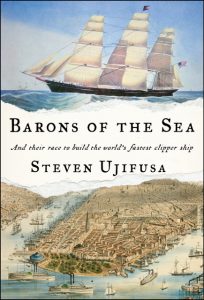Steven Ujifusa. Barons of the Sea. New York: Simon, 2018. Print.

Living in New England for much of my life, I would occasionally hear rumblings about prominent families who first made a name for themselves in the China Trade. Before the Gilded Age, before the Robber Barons, before even the Golden Spike, there was the China Trade. Barons of the Sea tells us about this.
That Americans could even trade in China before the Civil War was remarkable. China was the “middle kingdom.” It saw itself as set apart and indifferent to the rest of the world. Only two ports on the Pearl River, Canton (Guangzhou) and Hong Kong, were even open to foreign traders at the time. Macao was a Portuguese colony. That was it. The representatives of the trading firms lived in a confined area in Canton known collectively as the Factories.
Among the men—women rarely accompanied the men who sailed to stay there for years at a time—was the young Warren Delano. They would deal mostly in tea. When they were able, they would import opium from Turkey to China. (Ujifusa gives an evenhanded account of the First Opium War.) Here they learned things about sailing that they would apply to ship design. By the 1850s, clipper ships like the Flying Cloud were breaking records when speed from the East Coast to California was critical. Whoever was first with the latest crop of tea, whether to San Francisco, New York, or London, was sure to make more profit than those who came in later.
The name Delano should ring a bell. Warren Delano’s grandson through his daughter Sara would become President of the United States. But the family became well-connected in other ways. While some of the families involved in the China trade and the shipbuilding that went along with it never diversified, the Delanos did not keep all their eggs in one basket. Warren’s investments would keep the family prosperous long after the continental railroad and the steamship made the clipper ships obsolete.
What ships those clippers were! Barons of the Sea goes into some detail describing the various ways the ships were constructed. Some experiments did not work out so well. One enormous clipper caught fire shortly before its launch date. In this book we meet the sea captains, the shipbuilders, and the merchants who all contributed.
Often they were related as well. We learn about Abbot Low who financed many of the China and San Francisco voyages. His brother Charles longed for adventure and became a prominent ship captain. A sometime partner of both the Delanos and Lows was John Forbes, still a well-known name in finance. The niece of one of the financiers would be Hetty Green, herself a famous financier of the Gilded Age.
While this book is the result of much historical research, it reads like a lively novel. That is partly due to the names of some of the characters, to the adventures they experienced, and to the conflicts they endured. Many ships were lost, especially in hurricanes and around Cape Horn. Some survived shipwreck. Some made and lost hundreds of thousands of dollars, and then sometimes made the money back again.
We learn about the design of the ships. What made some ships fast did not always mean that they could carry much cargo. The ships that sailed from Turkey to China tended to be smaller to be faster and avoid notice. There seemed to be no limit to the square yards of sail used on some of the larger vessels to make them catch as much wind as they could.
We also learn about Houqua, a Chinese financier who was willing to risk social isolation at home by working with the foreign devils in the import-export business. Warren Delano considered him his true mentor, and the Delano family still owns a painted portrait of Houqua. Lest it sound exaggerated, even beggars asking them for alms addressed the foreign merchants as fanqui, foreign devils. China was very insular for such a large country. At least when I taught in China in 2000, I was normally referred to as lao wai, “honorable stranger.” (In some contexts it is seen as pejorative, but where I was I observed that addressing someone as lao was always understood as a sign of respect.)
The prosperity of the China traders may have helped contribute to their decline. As the ships got bigger or had more sails, they needed bigger crews, but it was hard to find sailors willing to go on such cruises. Many times the seamen were literally shanghaied out of taverns and brothels. Such characters did not always make great shipmates, and mutiny was often a possibility. So we read about at least one captain who was tried for murder for the treatment of a couple of the men on his ship. Let us just say that he never repented. As we used to say in the Navy and Coast Guard, the ships were wood and the men were steel, not the other way around as they are today.
The author of Barons of the Sea does sometimes resort to nautical terms which many readers may not be familiar with. He very kindly included an appendix with illustrations to show the construction and rigging of the vessels to help the reader. All in all, Barons of the Sea is a stirring treasure, and truly a testimony to how the United States grew prosperous and would become a world power after its Civil War and into the Twentieth Century.